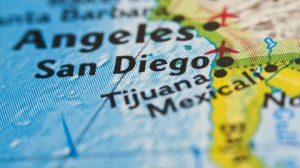 Pop Quiz: Where is the political center of the LGBT community? Urban Mo’s? No, though you could make an argument that it’s the social center. At 3909 Centre Street? No, that’s The Center, with a capital C.
Pop Quiz: Where is the political center of the LGBT community? Urban Mo’s? No, though you could make an argument that it’s the social center. At 3909 Centre Street? No, that’s The Center, with a capital C.
It’s actually somewhere near the intersection of University Avenue and the I-805 in North Park. If you want to see it, then you better hurry, because it’s about to move.
For most purposes, the LGBT community is an idea. It’s a way of encompassing our LGBT brothers and sisters, our allies and our supporters. To the extent that it is a place, its borders are defined by where we feel safe and accepted, not by lines on a map.
For political purposes, though, the San Diego LGBT community has been a concrete place since 1991. In the redistricting that followed the 1990 U.S. Census, the San Diego Redistricting Commission recognized the LGBT community as a “community of interest,” that should be kept together to ensure equal representation.
When they drew the map in 1991, the commissioners created District 3, largely, but not solely, to ensure that LGBT people with common political, social and economic interests would be represented.
It’s been a smashing success. Prior to 1991, no openly LGBT person had been elected to the San Diego City Council. Christine Kehoe won the District 3 seat in 1993, and it hasn’t been held by a straight person since. To keep that streak alive, members of the San Diego LGBT community are working together to convince the 2011 Redistricting Commission to maintain our “community of interest” status.
Unfortunately, things may be tougher this year. Not only do the commissioners have to alter the map to reflect population changes, but they have to create a new 9th Council District. Before they can even consider communities of interest, they have to comply with the Voting Rights Act and ensure each district has as close to 145,267 residents as possible.
To reach that number, District 3 has to lose nearly 7,000 residents. No problem, right? Maybe we can just give South Park to District 8. Except that District 8 already needs to drop 16,000 voters. In fact, every current district has to lose people, and they all need to end up in District 9, which doesn’t even exist yet.
Not to mention we haven’t asked the people in South Park what they want. Not that it’s really clear who speaks for a community. A town council? A business association?
For that matter, who are the “we” that are allegedly asking? Presumably, “we” are the neighborhoods crucial to ensuring representation for the LGBT community of interest. Since the census doesn’t really ask about sexual orientation or gender identity, we have to map other data to identify those neighborhoods. This “surrogate data” lets other agendas into the equation, making it unclear who is using their map to support the LGBT community, and who’s using the LGBT community to support their map.
Good-hearted people could make a strong argument for defining the LGBT Community of interest as people who voted “No on 8.” As that map could add Mission Hills and Banker’s Hill, and thus SRO, some members of the transgender community might concur. As it also excludes parts of City Heights, others with less laudable motives could use it as a way to limit the full diversity of our community. Some communities, including members of our own, may get better representation from another district and want City Heights to be cut out of District 3. While that wouldn’t absolve anyone’s motives, it would present a problem for Councilmember Todd Gloria, who lives in City Heights and might not want to move.
With all the personalities and agendas involved, a successful map becomes hard to imagine. That’s because success isn’t a single map. Success is a seat on the city council that ensures LGBT representations. To keep it, we need LGBT citizens to engage the Redistricting Commission with a unified message: “The LGBT community is a community of interest and should be preserved in redistricting.” If you can make it the first item on your agenda, I can probably live with the rest of it, as long as it respects the tolerance and diversity that define our community.











